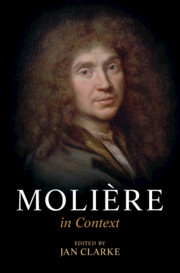Book contents
- Molière in Context
- Molière in Context
- Copyright page
- Dedication
- Contents
- Figures
- Charts and Tables
- Contributors
- Acknowledgements
- Translations
- Abbreviations
- Biographical Preface
- Part I Socio-Political Context
- Chapter 1 A Bourgeois at Court
- Chapter 2 The Religious Climate
- Chapter 3 Medicine
- Chapter 4 Family Law
- Chapter 5 Women
- Chapter 6 Gender, Masculinity and Cross-Dressing
- Part II Intellectual and Artistic Context
- Part III Theatrical Context (Paris)
- Part IV Theatrical Context (Court)
- Part V Reception and Dissemination
- Part VI Afterlives
- Further Reading
- Index
Chapter 6 - Gender, Masculinity and Cross-Dressing
from Part I - Socio-Political Context
Published online by Cambridge University Press: 10 November 2022
- Molière in Context
- Molière in Context
- Copyright page
- Dedication
- Contents
- Figures
- Charts and Tables
- Contributors
- Acknowledgements
- Translations
- Abbreviations
- Biographical Preface
- Part I Socio-Political Context
- Chapter 1 A Bourgeois at Court
- Chapter 2 The Religious Climate
- Chapter 3 Medicine
- Chapter 4 Family Law
- Chapter 5 Women
- Chapter 6 Gender, Masculinity and Cross-Dressing
- Part II Intellectual and Artistic Context
- Part III Theatrical Context (Paris)
- Part IV Theatrical Context (Court)
- Part V Reception and Dissemination
- Part VI Afterlives
- Further Reading
- Index
Summary
An abiding concern throughout Molière’s works, masculinity is a more multivalent, complex and nuanced phenomenon than one might expect. Focussing primarily on various external signifiers coded as masculine – particularly elements of appearance and dress such as swords, hairstyles, and beards – this chapter outlines the various forms that seventeenth-century masculinity can take when it intersects with other variables of age, social class, biological sex and so forth. For example, while the barbons of the older generation regard their beards as an unassailable symbol of male authority, they are troubled by their younger blondin rivals, whose gallantry and blond wigs strike them as effeminate. An even more affected mode of masculinity can be found in the bodily stylisations and verbal uncouthness of the aristocratic petits marquis. As this chapter demonstrates, masculinity in Molière emerges as something largely performed or asserted in relation to others – through domination of women or competition with other men (in duels, warfare or seduction). Such issues are starkly flagged up when cross-dressing or cross-casting are involved: in many of Molière’s plays, women’s success at passing as men, and men’s failure to pass as women, can often demonstrate the fragility of both social gender roles and men’s authority.
- Type
- Chapter
- Information
- Molière in Context , pp. 60 - 68Publisher: Cambridge University PressPrint publication year: 2022

